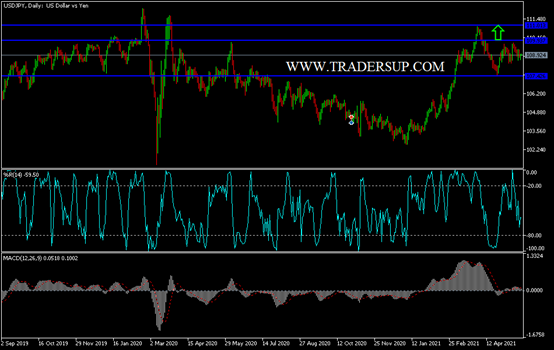In light of the continuing pressures on the US dollar, the USD/JPY during last week’s trading, retreated to the support level of 108.57. The attempts to rebound higher did not succeed in surpassing the resistance 109.33 and stabilized at the beginning of this week’s trading around the 108.98 level. The US dollar gained at the end of the week against the rest of the major currencies, after IHS Markit said that the US services sector PMI rose from an upwardly revised 64.7 reading in April to a record high of 70.1 in May as more of the US economy reopened, leading to more activity and production in the sector.
Meanwhile, the US Manufacturing PMI also advanced to a new record high of 61.5 in May from a reading of 60.5 the previous month, with both lending weight in the view that the world's largest economy has likely shifted to a higher level. “The latest PMIs reinforce our view that the economy will continue to grow at a faster rate in the US compared to the Eurozone in the next few years,” said Simona Gambarini of Capital Economics. This feeds our expectations that long-term yields will rise more quickly in the past than in the last and that the euro will decline against the US dollar
Overall, the strong US recovery is ultimately a boon to economies elsewhere in the world as well as their currencies, despite a surge in US government bond yields on Friday and in the immediate aftermath of the issuance and appeared to catalyze another rally quickly..
Prior to this release, initial US jobless claims came in better than expected at 444k versus 450k. However, the Philadelphia Manufacturing PMI is disappointing at 31.5 versus an expectation of 43.
From Japan, the BOJ's preliminary manufacturing PMI for May missed the forecast of 53.8 with a change of 52.5. The National Consumer Price Index excluding food and energy was below the expected change (year over year) by 0.5% with a change of -0.2%. On the other hand, the national consumer price index surpassed -0.2%, by -0.1%.
At the end of last week, Japan expanded the state of emergency related to the Corona virus, hours after it approved the use of two other vaccines in an attempt to contain a worrying increase in infections nine weeks before the opening of the Tokyo Olympics. Although there is no forced closure, the state of emergency allows county governors to require stores and public institutions to close or shorten their working hours. It expanded from hotspots in Osaka and Tokyo in late April to other areas earlier this month, and currently covers 42% of Japan's population.
Last Friday, the government announced a decision to add Okinawa, the Southern Archipelago that hosts most of the US military forces stationed in Japan, starting from Sunday. Earlier on Friday, Japan agreed to produce and use the Moderna and AstraZeneca vaccines. In this regard, Minister of Health Norihisa Tamura said that the two vaccines will help accelerate vaccination. Japan gave one or more doses of vaccines to about 5 million people, or just 4% of the population, with the doses of Pfizer that were approved in February.
According to the technical analysis of the pair: In the short term and according to the performance on the hourly chart, it appears that the US dollar against the yen is trading within the formation of a descending channel. This indicates significant downward short-term momentum in market sentiment. The pair has recently bounced back to rise near overbought levels in the 14-hour RSI. Accordingly, the bulls will look to move on the impact of this bounce by targeting profits around 109.18 or higher at 109.48. On the other hand, the bears will target short-term gains around the support level of 108.65 or below the support level of 108.34.
In the long term and according to the performance on the daily time frame chart, it appears that the US dollar against the yen is trading within the formation of a sharp ascending channel. This indicates a strong long-term bullish momentum in market sentiment. The pair has recently pulled back to avoid rising to overbought levels in the 14-day RSI. Accordingly, the bears will target the long-term pullback gains around 107.71 support or less at 106.55 support. On the other hand, the bulls will be looking for profits at around 109.82 resistance or higher at 110.78 resistance


